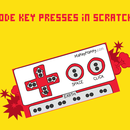Introduction: Kid Friendly Alligator Clips and Conductivity Game With Makey Makey
Hack a clothespin with conductive fabric tape from the Inventor Booster Pack to make a kid-friendly alligator clips and conductivity testers.
Supplies
Makey Makey Classic, Inventor Booster Pack, Wire Strippers, Electrical Tape
Step 1: Hack #1: Create a Kid Friendly Alligator Clip:
- Take apart a clothespin.
- Add conductive fabric tape from the inventor booster kit on the inside of each clothespin.
- On one wooden piece of the clothespin, make sure you wrap fabric tape from the teeth to the end of the wood so you can clip your alligator clip onto it.
- Put the clothespin back together.
- Clip an alligator clip onto the end of the clothespin with the fabric tape.
- Insulate the fabric tape by covering it with masking tape.
Educator Tip:
Make these clothespins yourself, or challenge students to make them. They will learn a lot about conductivity just making and tinkering and trying to figure out how to make the clothespin work just like the alligator clip.
Step 2: Hack #2: Conductivity Tester Alligator Clip
You can use this same idea to make an alligator clip with both a key press and EARTH to test items for conductivity.
Have students make "Is it conductive?" games and create a display of items that may or may not be conductive. Have them test each item with your newly hacked "Conductivity tester" clothespin.
Note: Scratch runs the code from top to bottom, so there is a bit of a lag when testing your materials. Make sure you give the code time to run through and before deciding your item is conductive or not.
- Video of original game play
- Scratch Game (to remix or share ideas for coding)
Step 3: Teach Scratch Tips
Scratch Tips
How can you trigger events? How do "if/else statements" work? When do you need a "forever" loop in a game?
Note: Scratch runs the code from top to bottom, so there is a bit of a lag when testing materials. Make sure to give the code time to run through and before deciding if an item is conductive or not.
Picture 1: Scratch 2
Picture 2: Scratch 3
Educator Tip:
When Flag Clicked
In the code above, my game starts "when the green flag" is clicked. At this point, the squirrel will say, "Is it conductive? Let's find out." This will play only once at the start of a game. After Scratch runs this code, it will not check for it again unless I click the green flag again, which will restart the game.
If/else statements
An "if" statement tells the Scratch game to check "if" something happens "if" my computer detects the right arrow is pressed, then the squirrel will say "Yes! That is conductive." "Else" tells my computer that "otherwise" if my right arrow is NOT pressed, then the squirrel will think "Hmm... are you grabbing air?" and then say, "Nope, try again."
Forever loops
To make my Scratch game consistently check whether the right arrow key is pressed or not, I've placed it inside a "forever" loop. This tells the game that once the flag is clicked, to "forever" look and see if the right arrow key is pressed (if so, say "Yes! That is conductive") or no, the right arrow key is not pressed (else say "Nope, try again.")
Note: Scratch runs the code from top to bottom, so there is a bit of a lag when testing materials. Make sure students give the code time to run through and before deciding if an item is conductive or not. Use a forever loop around anything you want to ALWAYS be at play in your Scratch game or animation.




